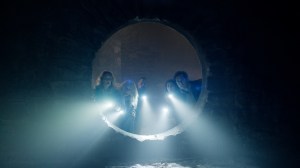Ninjas, if anything, are known for their precision. Deadly with blades both big and small, these sneaky assassins are famous in almost all forms of media for their ability to provide such pleasing (and often violent) spectacles that often depend on mobility. Shinobi: Art of Vengeance, the first new entry in the long-running series since the oft-forgotten 2011 3DS installment, understands this need for precision. When everything is moving swimmingly, Art of Vengeance is a rewarding action platformer with an absolutely stunning art style. But there are also times when it loses grip on its ninja-like smoothness and becomes a slightly clunky action platformer with an absolutely stunning art style.
Videos by ComicBook.com
The impressiveness within the art is worth reiterating because it’s a game that shines from the splash screen and never lets up. The brilliance of its hand-drawn aesthetic fills the frame with immaculately detailed backgrounds — like its huge fish market that has all sorts of unique aquatic restaurants and castles containing layers upon layers of tiles and decorations — and sweeping vistas, all of which are drenched in a swath of bright, eye-catching hues.
Putting the “Art” in “Art of Vengeance”

Bosses are introduced with intricate title cards and cap off with wallpaper-worthy finishing flashes. Special ultimate attacks see famed protagonist Joe Musashi slam down scrolls that summon vast spirits or turn Super Saiyan and evoke mythical fiery dragon spirits that swim across the screen, burning a path of destruction in their wake. Aside from the freakishly thin character portraits for two of the female heroes, there’s hardly a time when Art of Vengeance looks anything but gorgeous. Developer Lizardcube is known for its phenomenal work on Streets of Rage 4, but the clarity of the visuals in Art of Vengeance and the beauty of the animation that brings it all to life demonstrate the team’s ability to top itself and what best-in-class 2D art looks like.
Art of Vengeance’s smooth animation is most notable during its platforming and combat, which is what makes up the bulk of the gameplay. Jumping and dashing around benefits from the (mostly) smooth controls and is solid if unremarkable due to these sections not being too complicated. They’re mainly simple gauntlets of grappling hook points and floating platforms that do little to push players or present anything many of its genre peers haven’t done.
Ninja May Cry

Even though there are some thrilling chases that ratchet up the stakes, they’re often a means to get to the Art of Vengeance‘s many combat arenas. Melee bouts are appropriately fast and are built around using juggles to efficiently dispatch all types of demons, soldiers, and robots in just a few slices. Its array of unlockable attacks are thoughtfully constructed since they often naturally link right into one another. For example, a foe can be sent flying with one of the heavy finishers and then can be further kept up in the air with the kick attack players can do from a dash.
It’s an open system that rewards those skilled enough to maximize each move with free-flowing melee fights that almost feel choreographed. Capping off a climactic round with an execution — which is possible after building up a gauge under the opponent’s health bar — is the perfect cinematic coup de grâce that only gets more satisfying when the scores of orbs and coins explode out of each freshly slain corpse. Even bosses can be comboed and executed, empowering players to even feel strong in its toughest fights.
A Slightly Dulled Blade

But Art of Vengeance has enough small issues that interrupt this flow and keep it from greatness. Executions are strangely relegated to pressing two shoulder buttons at the same time and are an overly messy input that, because they share the same button, often leads to an ill-advised dash in the heat of battle. Special Ninpo and Ninjutsu abilities also require multiple buttons and aren’t as instantaneous as they should be. Some attacks also have surprisingly long recovery animations and keep players from rolling out the way in time, meaning the crucial act of evading isn’t always as consistent as it should be. It might only be a few frames of extra recovery, but it’s noticeable in a game this fast.
Responsiveness is key in an action-heavy title like this so any inconsistencies — whether they come from putting a time-sensitive execution on a fiddly two-button input or having to wait for the Ninpo or Ninjutsu menu to pop up while an enemy ninja is rushing in — stick out even more and have a wider negative impact than they would in a slower game. And when combined with occasionally odd checkpoints, annoyingly large violet-tinted attacks that blow through dodges, and its handful of uncharacteristically sluggish vehicle sections, Art of Vengeance’s best moments are sometimes slightly sullied by its worst tendencies. These flawed tendencies become even more obvious in the final act when the game’s increased difficulty makes them harder to ignore.
Shinobi: Art of Vengeance loses its footing a fair number of times, but that doesn’t completely overwrite when it swiftly strikes its target with the kind of grace only a ninja can wield. Dropping combos because of sometimes unwieldy button combinations or unexpectedly long recovery periods is frustrating, but executing three goons at once after a lengthy juggle is always gratifying, especially when it’s consistently supported by some of the prettiest 2D art in the medium. Even though the “art” may be stronger than the “vengeance” in Art of Vengeance, they still come together to form an experience that’s still plenty sharp.
Rating: 3.5 out of 5
A review copy for PS5 was provided by the publisher for the purpose of this review.









